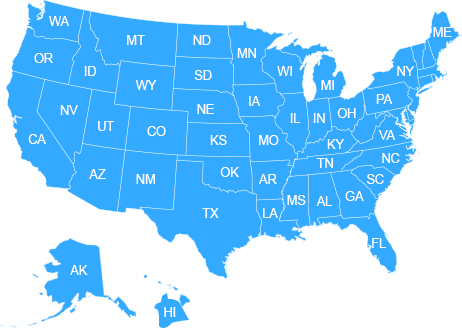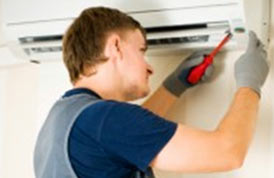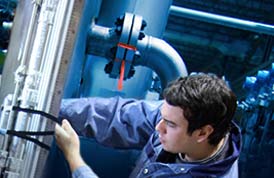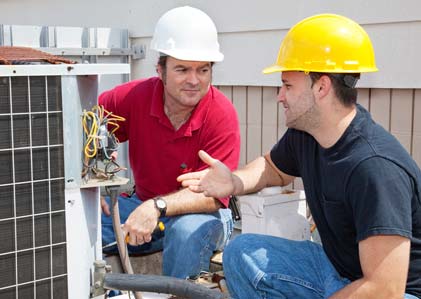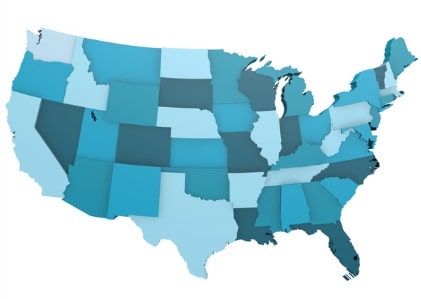For those interested in learning the fundamentals of the HVAC field, there are educational programs available throughout the country in addition to distance-based options at every level: certificate, associate’s, and bachelor’s programs.
Following is what students can expect from various HVAC certificate and degree programs.
HVAC Certificate Programs
University of California, Berkeley Extension
The University of California, Berkeley Extension offers an HVAC certificate program with both classroom-based and online learning opportunities. The program provides students with a structured approach helping them learn in-depth technical applications and principles they need for designing new HVAC systems and retrofitting existing systems. The faculty of the program includes working professionals who have several years of practical experience.
Students will complete 165 hours of coursework in areas such as system design considerations, system load calculations and psychrometry (i.e., properties of gas-vapor mixtures), and ductwork and piping systems.
In addition to their certification, graduates receive a certificate of accomplishment from the Golden Gate chapter of the American Society for Heating, Refrigeration and Air-Conditioning Engineers (ASHRAE).
University of Northwestern Ohio
The University of Northwestern Ohio (UNOH) in Lima provides a PAHRA-accredited HVAC/R certificate program, training students in the fundamentals of furnace technology, commercial refrigeration, and air conditioners.
In a combination of rigorous hands-on instruction with qualified HVAC professionals and Simutech computer exercises, UNOH teaches students the latest in service and procedures, heating systems and controls, applications of refrigeration and temperature controls, and other cornerstones of the field. Finally, UNOH boasts small class sizes with a maximum of 20 students and also offers an HVAC/R associate’s degree program.
HVAC Associate’s Degrees
Front Range Community College
Front Range Community College in Loveland, Colorado provides a PAHRA-accredited associate of applied science (AAS) degree in HVACR. Helping students explore all aspects of HVAC/R, this program all levels of training HVAC/R.
With 60 credits of classes in areas such as refrigerant tubing, basic electricity & electrical components, and HVACR troubleshooting, Front Range’s program takes four semesters to complete. In addition to didactic coursework, students have the option to complete a capstone project or supervised internship to put their newfound knowledge of fabrication, brazing, soldering, and more to the test.
Upon completion, students will be able to service or perform general maintenance on HVAC/R systems, troubleshoot common HVAC/R electrical devices, safely work with and handle refrigerants, and gain a complete understanding of the common tools that are used in the HVAC/R trade. Apart from the AAS degree, the college also offers several certificate programs in HVAC/R.
Location: Westminster, CO
Accreditation: The Higher Learning Commission, PARHA
Mount San Antonio College
Mount San Antonio College (MTSAC) in Walnut, California provides an associate of science (AS) degree in air conditioning and refrigeration technology. As the only PAHRA-accredited program in the state of California, MTSAC has a work-study component for interested students in addition to training in refrigerant handling, welding, and mechanical & electrical operation. This program is also offered as a certificate.
The AAS degree program is made up of 61.5 credits including courses such as refrigeration fundamentals, heat load calculations and design, gas heating fundamentals, air property/measurement, commercial systems, and air conditioning codes/standards, among others.
The HVAC/R program prepares students for employment in this broad field of HVAC/R leading to occupations in manufacturing, design, operation, distribution, sales, maintenance, installation, controls, and repairs.
HVAC Bachelor’s Degrees
New York City College of Technology
The New York City College of Technology in Brooklyn provides a bachelor’s of technology (BTech) degree program in facilities management. This program is an extension of the school’s associate of applied science (AAS) degree in environmental control technology (HVAC) and gives students a working understanding of how to maintain comfortable indoor climates while paying thought to energy conservation and efficiency. This bachelor’s degree may be an especially attractive option for aspiring HVAC professionals who are interested in taking on management roles and increased responsibilities.
Comprising 120 credits, this bachelor’s degree includes coursework in principles of refrigeration, principles of air conditioning, hydronic systems design, principles of facilities management, project management for facilities managers, building systems, and financial analysis for facilities managers, among others.
Graduates of the program are prepared for careers as facility managers in hospitals, large commercial buildings, residential complexes, institutions, and universities.
Ferris State University
A bachelor of science in HVAC/R offered by Ferris State University is a continuation of the AAS in HVACR technology degree. Providing students with a balance of application and theory, this bachelor’s degree offers a solid foundation grounded in the principles of HVAC/R combined with extensive laboratory experience.
Consisting of 124 credits, the program includes courses such as control theory and application, HVAC hydronic system select design, load analysis & energy modeling, contracting issues in HVAC/R, direct digital control, and commercial HVAC system design.
The major admission requirements include an associate of applied science (AAS) in HVAC/R technology (HVAR) program at Ferris State University or an equivalent associate program at another institution with a minimum 2.50 GPA and computer literacy skills.
Students learn about load calculations for determining building cooling and heating needs. They also learn to design processes and principles, operate mechanical systems, and energy audits and analysis.
For more information on four-year HVAC and HVACR programs, please visit the top HVAC bachelor’s degrees page.
Online HVAC Degrees
Ashworth College
Ashworth College based in Norcross, Georgia provides an online career diploma in heating and air conditioning that can be completed in as little as four months. The Ashworth program includes a voucher towards the student’s cost of certification from ESCO. The program is ideal for anyone who wants to enhance their current skills and prepare for a high-demand field.
Students through this program gain the essential skills and knowledge needed for successfully installing, troubleshooting, and maintaining HVAC systems for commercial and residential buildings. This HVAC program includes lessons such as the HVAC/R field, HVAC/R tools, testing instruments & service equipment, learning at Ashworth, refrigeration systems, and refrigerant properties and management.
Penn Foster (sponsor)
Penn Foster is a college accredited by the Distance Education Accrediting Commission (DEAC) and offers an online HVAC career diploma. As part of the program, students receive a voucher to sit for the EPA certification—a mandatory credential for workers who handle refrigerants.
This online program comprises eight courses, helping students gain the skills and knowledge for performing HVAC/R repair jobs in a variety of settings. The curriculum explores topics such as math and electrical basics for HVAC/R, orientation to HVAC/R, fundamentals of HVAC/R, electrical systems, refrigeration systems, residential and light commercial HVAC/R systems, commercial refrigeration systems, and HVAC/R system design and installation.
Students will gain an understanding of the usage and composition of HVAC/R equipment, tools, and materials that are required for installing and diagnosing tasks, recognize safety procedures, understand the refrigeration cycle, understand processes and theories for installing and evaluating electrical systems and controls, and comprehend procedures to install, inspect, test, repair, and maintain HVACR systems.

